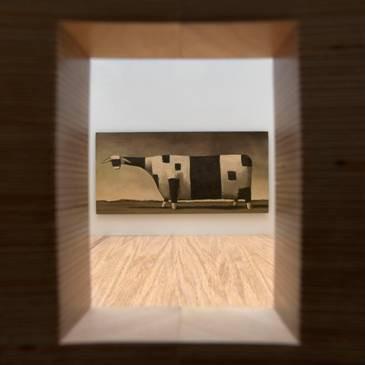Agnew’s Gallery, London W1
John Kelly was born in Bristol in 1965, of an English mother and Irish father. When he was six months’ old, his parents emigrated to Melbourne in Australia, where he trained as a fine artist – thanks to his mother winning a competition on the side of a milk carton that gave the family enough money to pay for his studies.
Kelly’s latest show at Agnew’s gallery in Mayfair features pieces from 2007 to 2009, encompassing all the major themes in his work: Australia, Ireland and his signature images of Dobell’s cows – based on Australian contemporary artist Sir William Dobell’s legendary cow installations on WWII airfields, designed to fool Japanese pilots.
Enter Agnew’s gallery and you are immediately drawn in by the voices of Kelly’s parents, telling the lyrical tale of their departure for Australia and their life there. Kelly has installed his Ma and Pa in a scale model of Tate Modern and their melodic voices meander round the mini-Tate – and your brain – not quite in synch and each telling a slightly different tale.
However, it is not long before the space-age sculpture you tried to sidestep on the way in grabs your attention, as you sense its enquiring lens pointing straight at your back.
The White Enterprise (2009) comes fully loaded with guns made from artists’ portfolio tubes and a CCTV bubble lens that records the movements of the gallery.
Its sister ship The Dark Enterprise (2009) hangs in the air like a benign threat as it coasts the space. The trick is that the viewer can never view himself, while all the time being viewed by the exhibits.
Each piece incorporates artists’ materials and is also the sculptural incarnation of a particular, internationally-renowned gallery – imagine the Guggenheim put through a car crusher.
In The White Enterprise, the Guggenheim’s pristine curves are neatly compacted in laser-cut MDF; in ‘Mum & Dad @ Tate Modern’ (2009), the gallery has been turned into a radiogram, complete with ‘crystal’ milk carton transmitter; and in The Probe (2007), Kelly comes home to Cork, with his moon-probe sculpture mimicking the soft-edged façade of Cork’s Lewis Gluckman Gallery.
The essence of these spaces – their formality through the selection and presentation of artworks, and the security of the CCTV systems that patrol the spaces – is distilled, as Kelly seizes control of each gallery through his sculptures.
Turning the tables – or maybe the easels – is what Kelly is all about.
In his essay, Melbourne to Monaco via Princess Grace Boulevard, Kelly muses on the similarities between a dog lolling on its back with its legs in the air – and an upturned chair, as described in an email from the Mother’s Tank Station gallery in Dublin:
“It’s drawing together of coincidental relationships was obviously intended with humour,” he notes.
Kelly himself seizes upon relationships between objects and the viewer and articulates them with resulting irony. In Probe, the sculptures are frequently elevated above us, so that we become almost childlike, gazing up to appraise them, while being surveyed from a lofty angle by something not human, but seemingly sentient.
Kelly’s works are not always designed to be suspended, however – The Probe’s easel legs proved too fragile to support the weight of the piece; but once airborne, Kelly’s work begins to exist and move in its own space – no longer earthbound, it comes alive.
In the basement gallery, moored like a captured UFO, is Halo (2007) – a Celtic cross housing box-frame mini galleries of more cows and kangaroos, including a tiny tribute to Kelly’s famous Millennium sculpture Cow up a Tree, which took Paris by storm. Viewers stand in the centre of the sculpture to survey the interior scenes – and Gina Agnew reveals that, in the future, Kelly is considering hanging the piece in a more elevated position, with a periscope for viewers to use.
On the way out, stop to absorb Kelly’s painting ‘Elements’ – a fusion of the artist’s influences (Kelly holds three passports), with paint dragged across a distressed canvas like organic matter. Kelly’s work often has a naïve and quirky element that imbues it with its own character and an autonomous sense of identity: in this case, it would be nice to think that one of Kelly’s signature cows or kangaroos had dawdled across the canvas when the artist’s back was turned and left its footprint for us to find.
Probe is at Agnew’s Gallery until 5 November.
The gallery is open Monday-Friday, 9.30am-5.30pm.
Agnew’s Gallery
35 Albemarle Street
London W1S 4JD.
Tel: 020 7290 9250





